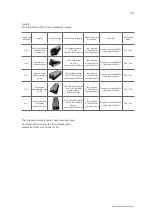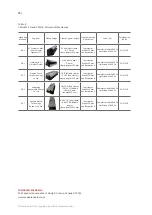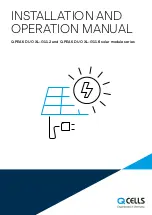
www.canadiansolar.com
| 7
· Only modules with similar electrical outputs
should be connected in the same series to avoid
or minimize mismatch effects in arrays.
· To minimize risk in the event of an indirect light-
ning strike, avoid forming loops when designing
the system.
· The recommended maximum series fuse rating
is stated in a table in the Annex.
· Modules should be safely fixed to bear all expected
loads, including wind and snow loads.
· A minimum clearance of 10 mm (0.394 in) or more
between modules is required to allow for thermal
expansion of the modules. The clearance is from
the plastic corner protector to adjacent plastic
corner protector.
OPTIMUM ORIENTATION AND TILT
· To maximize your annual yield, find out the optimum
orientation and tilt for PV modules in your region.
The highest yields are achieved when sunlight
shines perpendicularly onto the PV modules.
AVOID SHADING
· Even minor partial shading (e.g. from dirt deposits)
reduces yields. A module can be considered to be
unshaded if its entire surface is free from shading
all year round. Sunlight should be able to reach the
module even on the shortest day of the year.
· Permanent shading conditions can affect module
service lifetime, due to accelerated ageing of the
encapsulation material and thermal stress on the
bypass diodes.
RELIABLE VENTILATION
· Sufficient clearance (at least 10 cm (3.94 in)) bet
-
ween the module frame and the mounting surface
is required to allow cooling air to circulate
around the back of the module. This also enables
condensation or moisture to dissipate.
· According to UL 1703, any other specific clearan
-
ce required for maintaining a system fire rating
should prevail. Detailed clearance requirements
pertaining to system fire ratings must be provided
by your racking supplier.
5.1
MODULE WIRING
CORRECT WIRING SCHEME
· Ensure that the wiring is correct before starting up
the system. If the measured open circuit voltage
(Voc) and short-circuit current (Isc) differ from the
specifications, this indicates that there is a wiring
fault.
· When modules have been pre-installed but the
system has not been connected to the grid yet,
each module string should be kept under open-cir-
cuit conditions and proper actions should be taken
to avoid dust and moisture penetration inside the
connectors.
· For CS3U and CS3K series modules, Canadian Solar
Inc. offers optional cable specifications to match
various system configurations. Recommended
system cable schemes are shown in table 1:






































